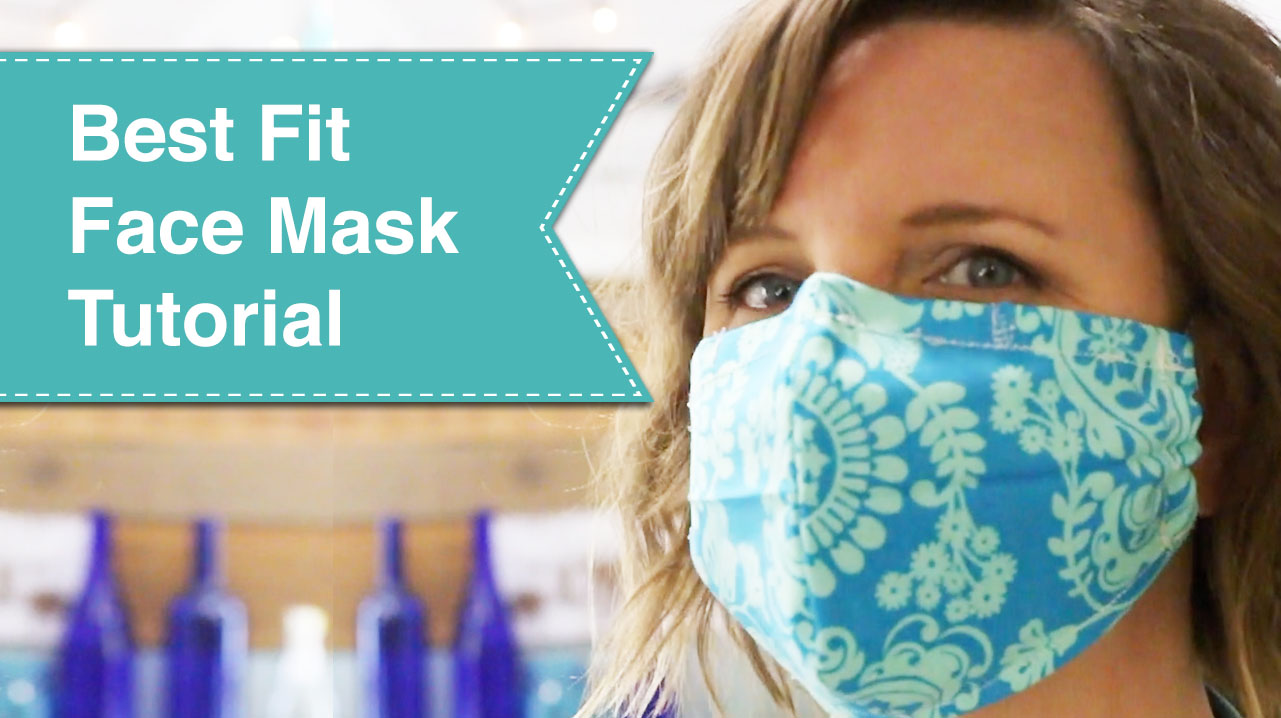
During the coronavirus outbreak I started making DIY Face Masks using some of the patterns I found online, but I really didn’t like the fit, especially because I was used to my more form-fitting and comfortable masks used for carpentry or demolition. So I designed what I’m calling the “Best Fit Facemask” tutorial. It’s more form-fitted onto the face and it has adjustable elastic ties around the ears to fit a wider variety of faces.
Best Fit Face Mask Tutorial
As a general contractor and woodworker, I had searched for form-fitting and comfortable masks to protect my lungs from dust and debris and had my favorites. For that reason, I knew there were better options than most of the sewing mask patterns I found. After a weekend, I designed this easy sew Best Fit Face Mask Tutorial for use by the public and medical professionals trying to protect N95 and surgical masks while also staying safe during the COVID crisis. (These are not a replacement for N95 or surgical masks. These masks are designed to add an additional layer of protection.) Looking for a simple, stylish, and better fitting face mask? Look no further.
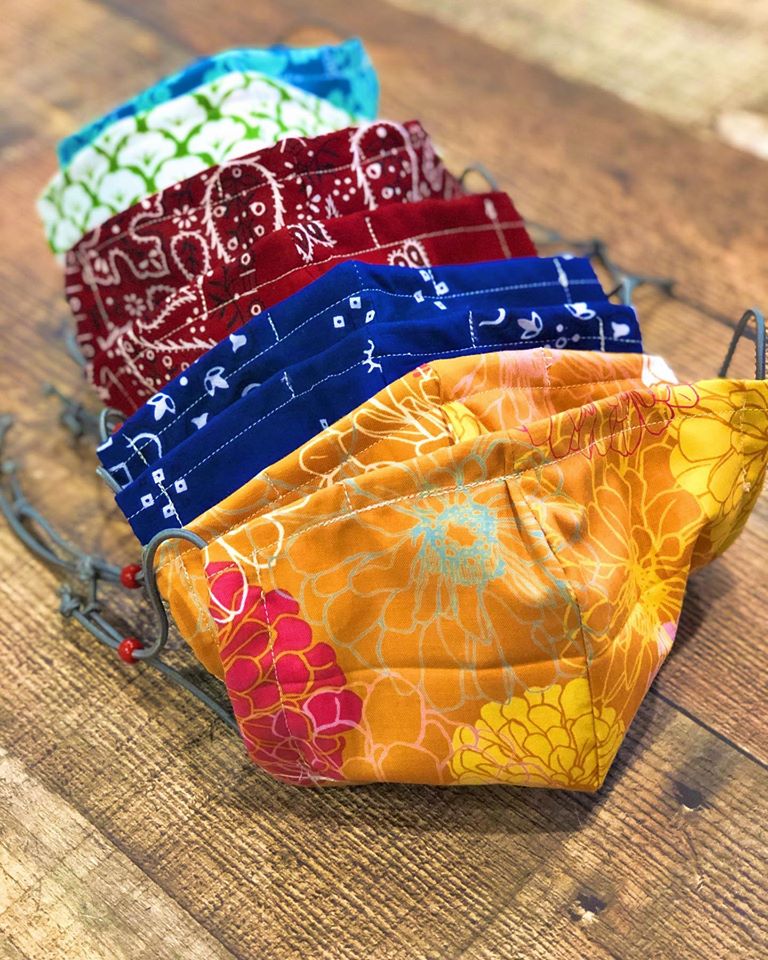
Face Mask Template Sizes:
After many requests, I finally have a variety of sizes. From a child size (fits approximately toddler to 5 year old) and then Small (fits youth and petite adult faces), Medium (fits most women or small men), Large (fits most men or larger women’s faces) and X-Large (fits long faces and men with beards.)
Even though you should pre-wash your fabric, the masks can still shrink slightly after the first post-construction wash. Therefore, check sizing after washing the finished mask.
Resizing: If you find the child size is too big, try printing at a 95%. Likewise, if the X-Large is still too small, try printing the pattern at 105%.
Does this mask have a filter pocket?
Filter Pockets or No Pocket, your choice! Instructions for sewing a mask with or without a filter pocket are included. In fact, it’s only one step difference. (Personally, I don’t use a filter pocket because it is harder to breathe through three or more layers.)
In addition to this pattern being easier to sew, it also uses less fabric to allow you to make more masks with the fabric you have on hand. Speaking of fabric, these are some sources for fabric in your home so you don’t have to buy anything!
Materials:
(I’ve included affiliate links for your convenience. I earn a small percentage from a purchase using these links. There is no additional cost to you. You can read more about affiliate links here.)
- Fabric (see below for suggestions)
- Scissors
- Thread
- Iron
- Elastic Strap material (see below for ideas)
- Nose clip materials (see below for suggestions)
- Craft bead (or buttons)
- Sewing Machine
Better Face Mask Fabric Materials:
There is some science behind the materials used for face masks. Although the tighter woven (more thread count) fabrics offer more protection, they do pose the issue of being harder to breathe through. If you want to choose the best materials for both, here is a list of best materials for making your DIY face mask when trying to prevent virus transmission.
Sources for Mask Materials in Your Home:
- Quilter’s Cotton Fabric
- Cotton Blend Fabric
- Sheets or Pillowcases
- Tea Towels (not terrycloth)
- Fabric Napkins
- Scarfs or Bandanas
- Flannel
- Dress Shirts
- Other Cotton Fabrics
- T-shirts (although the stretchiness makes them harder to sew.)
Nose Clip Materials:
My favorite nose clip material is the foam padded aluminum nose strip, but they are a little trickier to sew around. Second favorite are coffee bag ties (you can purchase them on Amazon or reclaim ones from coffee or donut bags.) An Instagram friend had suggested the coffee bag ties and I couldn’t be happier with the idea (thanks Nickolett!) But, despite our love of coffee, we didn’t have an endless supply of bags. And I could only make two nose clips from each bag tie.
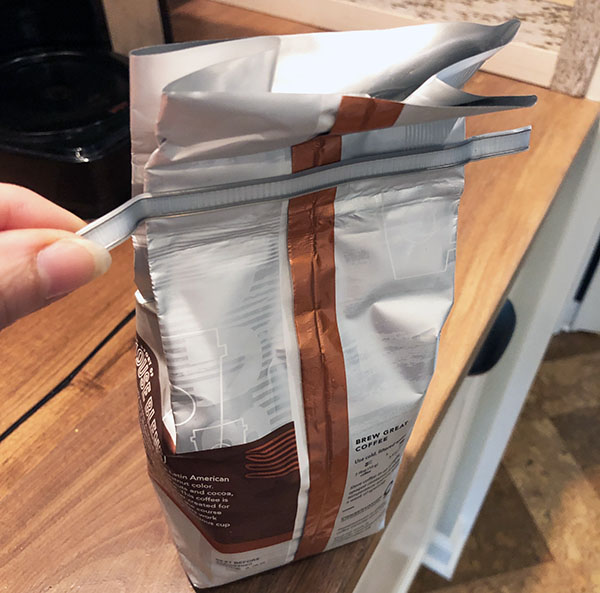
If you don’t want to purchase nose clips you may have these materials laying around:
- Electrical tape
- 18 gauge wire (or straightened paper clips)
Simple cut a piece of electrical tape 3 inches long. Lay two 2.5″ pieces of wire onto half the tape and fold over the other half to seal the wire inside the tape. Trim off the ends, leaving a small amount of tape to cover the wires. Yes, these will wash fine since the tape protects the wire. But any wire clips will eventually snap when bent back and forth too many times.
Less Successful Nose Clip Materials:
These items will work, but they either didn’t have enough of a “memory” in the bend, or they weren’t as comfortable. But, if it’s all you have, use it!
- Doubled Twisty Ties (not stong enough to hold shape.)
- Pipe Cleaners (tend to rust and break easier)
- Floral Wire
- Electrical Wire
- Triple-Layered cut-outs from foil take out containers
Adjustable Strap Materials:
I know the other materials that are hard to find are elastic, so here are a few acceptable alternatives.
- 1/8″ round shock or paracord (cut two 12 inch lengths per mask)
- Standard 55 (7 strand core) paracord (cut two 12 inch lengths per mask)
- 1″ cut strips of t-shirt material (cut 6-8 inch lengths and stretch to 12 inches long)
- Elastic Shoelaces (cut two 12 inch lengths per mask)
The key to the Best Fit Face Mask fitting so well is the adjustable straps. Using a craft bead on the straps allows the user to adjust the mask to their face. The paracord is the hardest to thread, but I found a great way to thread the strap material through the beads. Use fishing line folded in half. Thread the loop through the bead. Thread the strap material through the loop. Then pull the fishing line back through the bead.
The t-shirt material and elastic shoelace is much easier to thread through (especially when using the fishing line technique.) If you don’t have any of the above-mentioned strap material, you can use any cord or straps, but it’s crucial that the material can move freely in the sides so the side can gather at the back of your cheek. Stationary sewn straps will cause the material to push out away from your face.
No matter what material you use for the straps, be sure to tie the ends of your straps to prevent the bead from coming off. (And melt the ends with a lighter to prevent unraveling.)
If you don’t have craft beads, a button with some craft twine can work well as a strap adjuster. Or tie a slip knot following this video tutorial.
New Strap Design for The Most Comfortable Best Fit Face Mask!
With some schools opening back up and people going back to work, I made one change to the straps of the Best Fit Face Mask turning into my favorite mask and the Most Comfortable Best Fit Face Mask! Watch the video below for more information.
My Source for Flat Foldover Elastic to Make the Most Comfortable Best Fit Face Mask: Amazon or Etsy
Face Mask Templates:
The downloadable instructions contain the templates for both a medium and large size mask. Download by clicking on the images below which will take you to the full-size templates. Make sure your printer window is set to print actual size. Do not fit to paper size. Double-check your print out by measuring the one inch box on the template.
👉 Downloadable Instructions & Medium or Large Templates Here!👈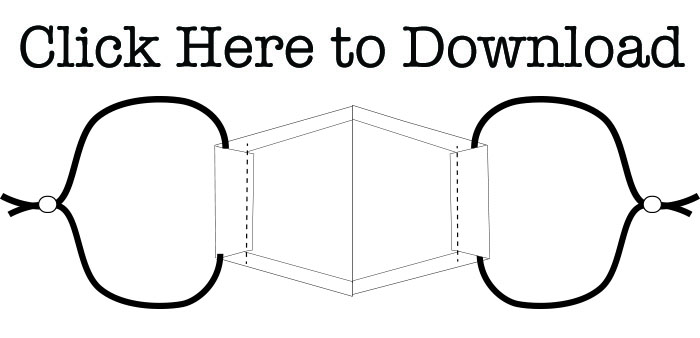
Looking for other size patterns? Download Patterns for other sizes below:
Don’t have a printer? Click on the links to see the dimensions of the Medium Best Fit Face Mask , Large Best Fit Face Mask, or Child, Small, and XLarge Face Mask.
Now, let’s get busy making the Best Fit Face Mask and be sure to share this tutorial with your friends and family so we can kick Coronavirus’s butt!
Video Tutorial:
Watching the video tutorial is the easiest way to learn how to make the Best Fit Facemask. Enjoy!
Instructions:
(Download Printable Instructions and Medium & Large Templates Here)
Print these instructions with the templates at the end. Make sure to print at actual size and check the size with the one inch box on the template.
1. Cut out the templates. Gently score along the dotted lines and fold.
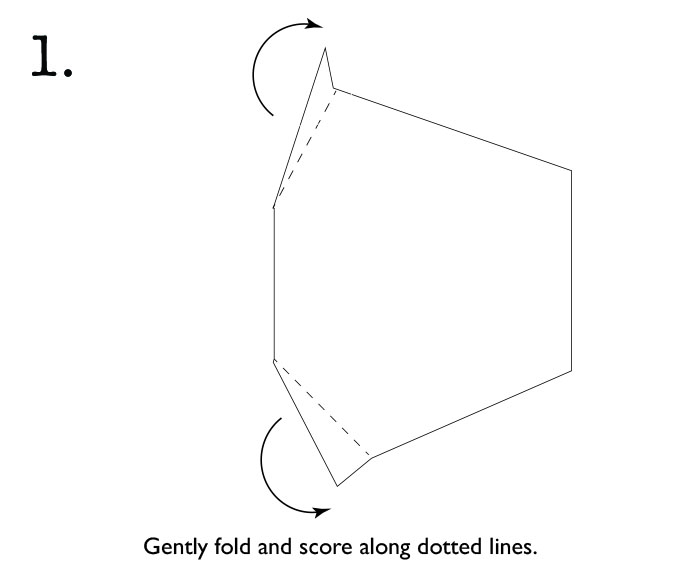
2. Trace the outside face mask template on your fabric. I designed the templates so you can get maximum use out of your fabric when making multiple masks. It helps to fold over the fabric and cut with the long sides of the template on the fold. But, you can rotate the template to fit more cuts out of the fabric. You’ll just have to seam together the pieces on the long side.
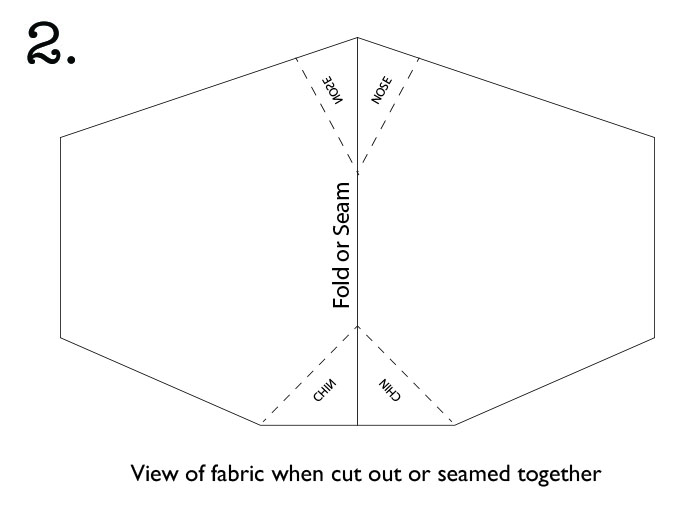
Lay your inside liner template onto your liner material. Trace and cut out fabric. (Important note: Hospitals are asking for masks with different fabrics for the outside and liner so they can visually see a difference.)
If you are making a filter pocket, you’ll need two liners (but only one outside piece.) If you need to connect two pieces of fabric together on the long side, do that now making sure right sides are together. I used a very small seam allowance.
3. Fold the corners of your template and mark a line onto your fabric at the fold. Repeat this on all pieces you cut out. Stitch along all the marked corners. If your fabric is printed, be sure your right sides are together. Now trim off the excess material at the corners making sure to cut close to the stitching.

4. Turn your outside mask material right sides out and press it with the iron. Lay the liner on top of the mask making sure the angled corners match for the nose and chin. Insert the liner fabric into the outside material and align the points and angles.
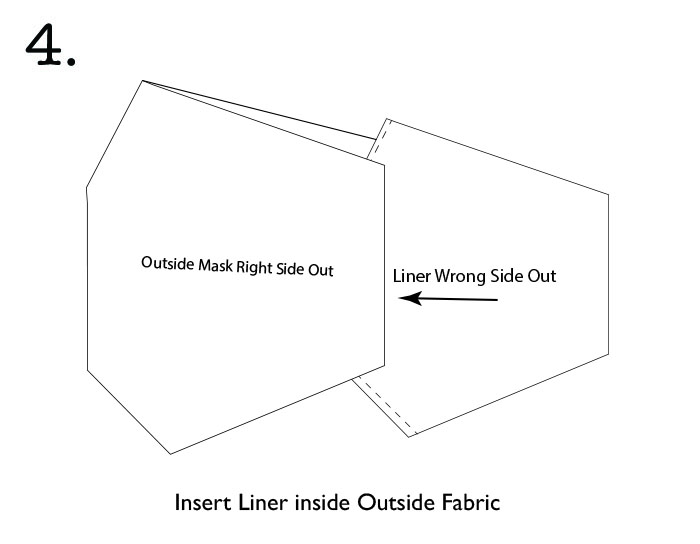
5. Then center the liner so there is an equal border of outside material around it.
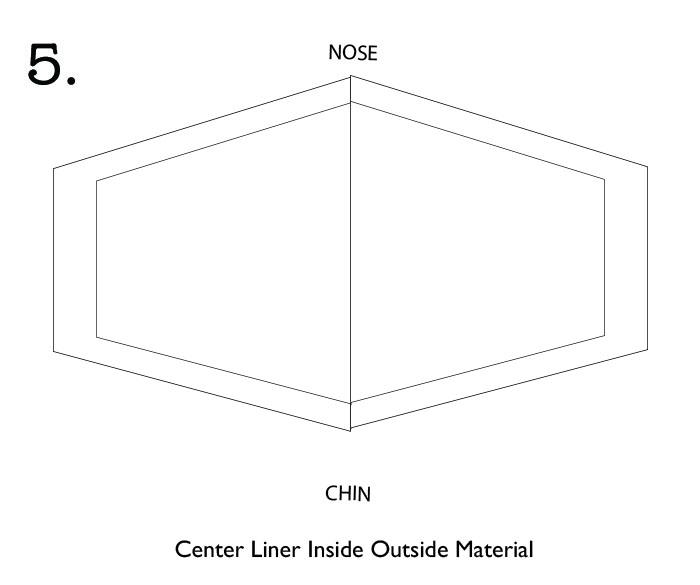
6. Fold over the outside material 1/2 inch to slightly overlap the edge of the liner. Press and then fold over the material a second time this time over the liner.
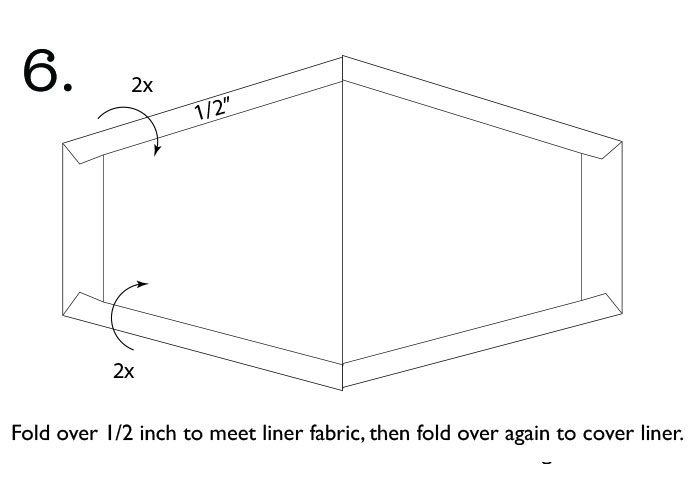
OPTIONAL:
Adding the Filter Pocket
This next step is only for those wanting to add a filter pocket. Just know that the more fabric you add, the harder the mask is to breathe through. Fold over ¾ an inch of the material twice at the ends of the second liner. Press it with the iron. Now stitch over both sides along this the edge to tack the fold-over in place. After stitching, insert the filter pocket on top of the liner (right side up), matching all the corner points. Then tuck it under the pre-ironed edges. If you need to, iron the edges again.
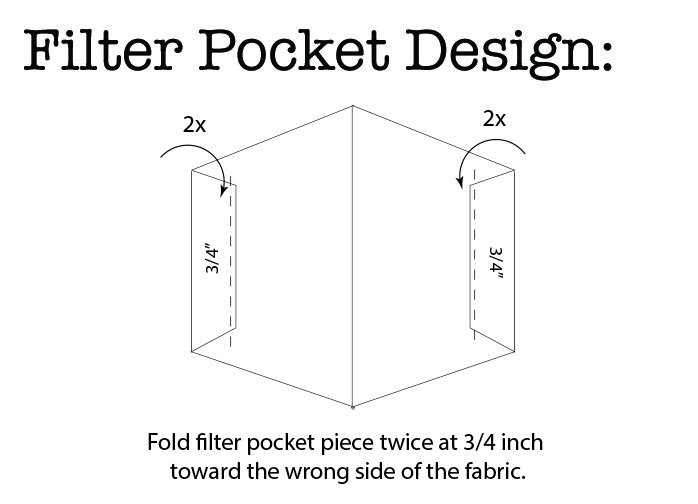
7. Locate the nose portion of the mask. Remember this is where you’ll be inserting the nose clip. Flatten the nose clip and tuck it under the binding of the nose. Use a clip or pin to hold the clip in place, but be careful not to put the pin all the way through the outside fabric layer so as not to add any large holes in the mask.
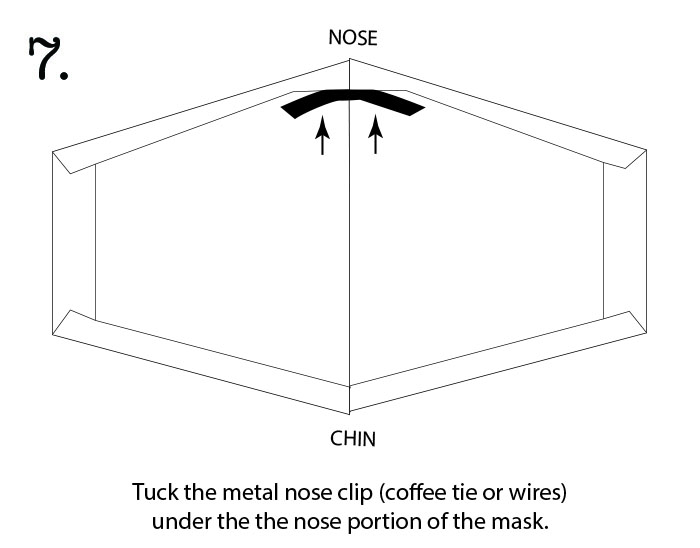
8. Stitch along the edge of the fold, being careful to avoid stitching onto the nose clip. Rotate the mask and stitch along the chin side of the mask.
Flip the mask over and feel for the nose clip. Sew a few stitches to the left and right of the nose clip to keep it from sliding around in the mask.
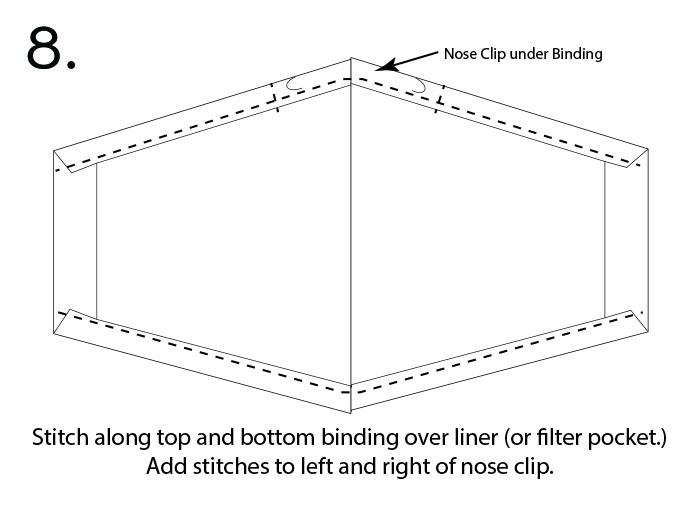
9. Double fold the ends of your mask about 3/4” twice to create a pocket for the ear straps. Be sure to avoid the filter pocket if you have one.
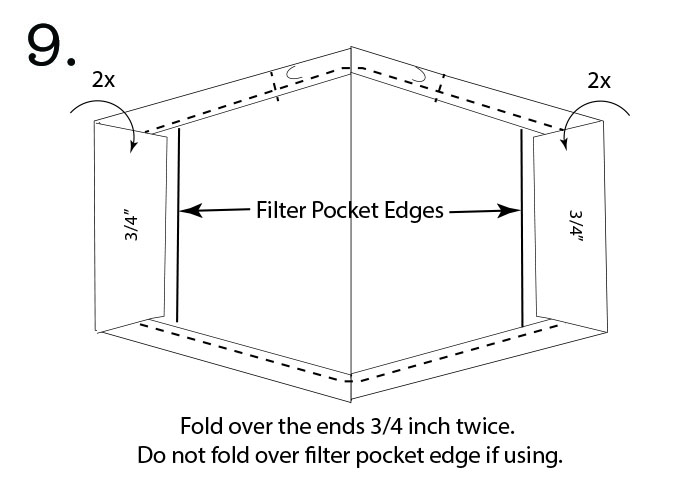
10. Time to grab the adjustable straps you made earlier. Take one strap and tuck it under the fold on the end. Stitch along the edge of the fold taking care not to stitch over the elastic. Repeat for the other side.
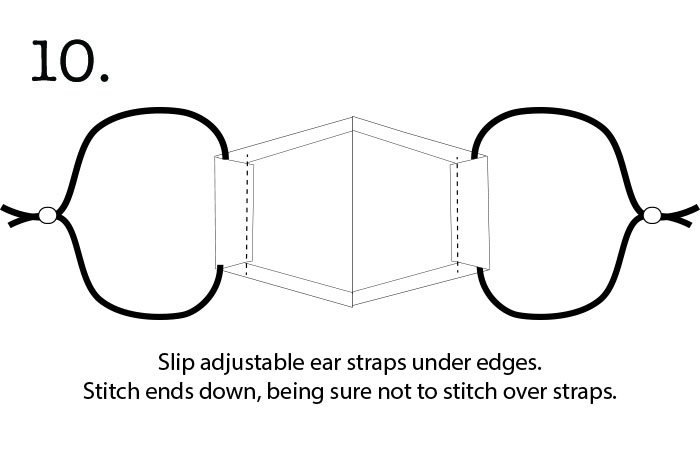
Make sure your straps still move freely in the fold. This allows the mask to cinch behind your cheek and not pucker.
This concludes your tutorial to make the Best Fit Face Mask.
UPDATE: I created a new video showing you some time-saving tips when making the Best Fit Face Mask. Plus, I answered a lot of questions! Watch this video to save time:
Everyone, please share this tutorial! Pin it, Tweet it, Facebook Share it, or Email it! Everyone should have a good fitting face mask for protection. After the Coronavirus is gone, these masks are great for woodworking or protection from seasonal pollen and allergens.
Stay kind, stay safe!
FAQs:
I appreciate all the comments, but I’m spending two hours a day replying to comments and emails. PLEASE READ THESE FAQs and check the COMMENTS below for answers to most asked questions before asking.
I also hope others can help answer questions if you see one. Thank you and take care.
• Where is the template? All the instructions and templates are on this page. If you can’t find it, please check again it’s linked under the Instruction section.
• Need Dimensions? They are included on this page. Look for the “Don’t have a printer?” link under Instructions.
• Who is selling them? This is an updated list of people who have contacted me and are selling face masks using my design.
• What size are the craft beads I used? The hole on my beads is 4mm.
• If I don’t have a bead, what can I use? Use a button and feed twine through the holes then tie them around your ear straps tight enough to hold the strap, but loose enough to be able to move the button. Or tie a slip knot (see the time saver video to learn how to tie a slip knot.)
• Can I skip the liner if using a filter pocket? At your own risk. I like to have two layers of fabric between me and the world. The filter pocket doesn’t extend all the way to the sides of the mask.
• What filter material should I use? Do your own research. Here’s a good article on options for filters.
• What material did you use for the liner? I used sheet material or a cotton curtain.
• Don’t have a particular material for this mask? I listed a variety of alternative materials on this page. There are plenty of other substitutes, but these are the ones I tried and can recommend.
• Are these washable? Absolutely. I wash mine before donating. The electric tape protects the wire from water. Frankly, the wire will break from repeated bending before it will rust.
• Is there a small or child size template? Do you have an X-Large size? YES!!! See the downloads and information for the child size, small, and X-Large above. (A child-size fits a four-year-old well but was a little too big for a two-year-old. You’ll have to play with printing the templates smaller or larger if these sizes don’t fit your needs. Or see the Time Saver Video to learn how to resize your template.
• Can’t thread your straps through the bead? Try using fishing line folded in half and feed through the bead loop first. Put strap material through the fishing line loop and pull it back through the bead. You can see a video of this process in my Time Saver Video.
• Video too fast? Don’t like the music? Keep your thoughts to yourself and download the instructions on this page. (Then you can play your own music and you can read it at your own pace.)

P.s. If you got to the end of this tutorial and still have questions, please read the comment section as many questions have been answered. I am receiving numerous questions and comments via email, YouTube, and the blog. It is impossible for me to answer all of them.
Pin this Tutorial for future use (or to share with others!)


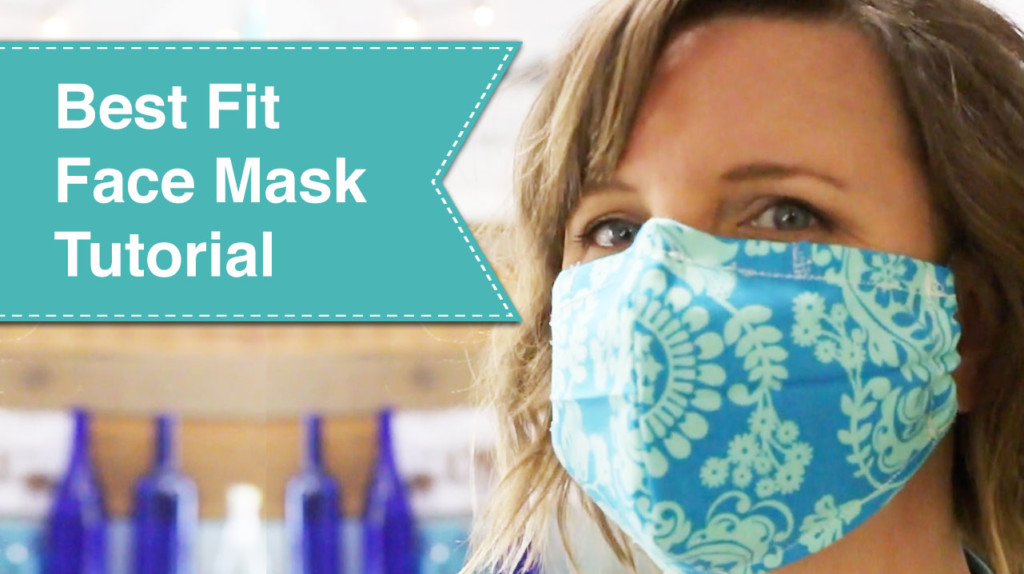
So sorry you’ve had so much trouble with the fit of titrations mask. I use the medium size pattern for myself, have no problem with the fit, also I wear progress lens glasses, no fog problem. Perhaps you should try the medium size pattern, and make sure the mask is not upside down.
After making several mask this pattern is by far the best fitting.
As a serial diy-er, your site is a great find. But this mask… Thank you so much! I have tried so many templates and this is the only one that is universally comfortable. Donating these to the Navajo, who have been really hard-hit. They need kid-sized masks and this scales down nicely, too at 12 percent.
Thanks Linda for your work to protect others and for letting me know about scaling the pattern.
Thanks so much for the time and effort you put into making the pattern for this mask. I agree this is the “best- fit” mask. I absolutely love this mask.
If I may reply to M.H. Freeman’s comment on June 4, 2020. I find it easier to put both pieces together when marking the “nose” area with a marking pen or chalk. Once the chin and nose area is cut after sewing, it can be a bit confusing to match the sides. Hope this helps… happy sewing
In reply to Loretta G questions on June 7, 2020, I most use fat quarters for making mask. They usually size 18″ x 21-24″. Usually cut 3-4 outside pieces for the medium mask, about 3 large mask. The same if using only for liners as well. When purchasing fabric to cut, 1/4 yd wi get about the same as the fat quarters, 1/2 yds, will get you more. Hopes this helps…
How is the electrical tape holding together in the washer and dryer over time? I’m just about to follow your instructions.
See the FAQs. Holds up fine!
Hi, I’ve now made about 8 of these. I’m thinking of trying one with the large pattern enlarged slightly so husband can fit his beard a little better! , Other than that, we really are liking the fit.
I thought I’d submit my own adventures in McGyvering.
First–coffee bag ties are a brilliant idea! So much so I went back and replaced the wires in the pleated masks I made before finding this pattern. I found pipe cleaners and wire ties from electrical cords or packaging, even doubled in electrical tape, don’t hold up too well in the wash–and we change out and wash masks daily here. I bought extra coffee and pulled old ties off my potting soil bags to use for masks–those things are really useful!
Second–as I was determined to use supplies I had around the house and the hair elastics I had were too short, I ended up going with “t-shirt yarn” for the straps, Problem: I had a some pony beads, but the holes weren’t big enough. I had been making pleated masks with longer straps that tied around the head, so I did that with a couple and it worked all right. I’d also used a single long cord that laced in one side and out the other on one of my pleated masks and really liked the fit, so I made a couple with those. I like that option as I have long hair and the fewer places I have to tie the mask, the less painful it is. On some masks I’ve made I’ve used spring-loaded toggles (these are used on some scrubby soap sacks and as those wore out I’d been throwing the toggles into my sewing basket for a few years) I’ve been determined to try the ear loops, however, and finally got an idea that worked for me. I cut 1/2″ pieces of some 1/4″ flexible tubing (leftover from an aquarium setup, or used as handles on some gift bags if you save those) and was able to make fitted ear loops with the t-shirt yarn. It works very well, and the thin tubing is comfortable behind the ears. I had to make a run to a craft shop today and picked up some oval-shaped large-hole beads (good for kids’ crafts), so on my next attempt I will give them a try.
I am interested in knowing how the bead works. Does it sit behind your ears? Wouldn’t this be uncomfortable.
Or does it hide in fold ?
If anyone can answer this that would be great, I can’t look thru over 14 pages of comments to find that the question is not answered.
Anyone know how much fabric is needed to make one mask? I have a couple fat quarters and just a bunch of other scrap fabric but if I buy fabric approx how much should I get? I know say a yard will make multiples but would it be best to buy say a yard and ???? 1/4 , 1/3, 1/8, etc. Any help I can get would be great. Thanks and thank you for this pattern!
I bought a bunch of fat quarters. Each fat quarter allowed me to cut 3 outside mask templates. (But, not the liners.) Hope that helps.
I have been making these masks for members of Makersmiths (www.makersmiths.org- a nonprofit maker space in Loudoun, VA), family members and friends. The CDC now recommends 3 layers for face masks and your masks have four if a pocket is added and a filter is used! I added your link to our Events/Classes page on our organization’s webpage so members can find it. I know people are using your tutorial since I hear from them and they are very grateful to have the resources. On another note, I teach for Shenandoah University (I am a teacher educator) and last week the university sent Makersmiths two Physical Therapy (PT) students from Shenandoah University to Makersmiths to help us assemble face shields that we are making for health professionals. One PT student had a paper mask on that was way too big for her face. I gave her one of the masks I made from your design and that one had a great fit for her. I was thinking that PT students are doing a lot of bending when doing therapy. I think she will find it very handy to wear during her clinical rotations later this summer! Thank you so much for making this tutorial available.
Thanks for letting me know Diane! That’s wonderful.
thank you. so easy for me to make . changed by using two fronts together . my friends love them they can breath . especially we are over 70 also use ponytail bands and cut and put one on each end so they can tie them to fit. husband likes that,
If anyone can help me it would be awesome. We LOVE this mask best of all. I am not accomplished with sewing machine. I have 2 things I need help with. (1) Brittany easily fits the linings into the outer mask. I have trouble getting my linings in straight and lined up. Is there a trick to this? (2) Brittany easily turns the edges over the lining then inserts the pocket and easily fits that in. Even though I cut lining and pocket perfectly there does not seem to be enough outer fabric to turn and cover as much as hers. Is anyone cutting linings smaller? Thanks so much. SUCH A GREAT PATTERN AND TECHNIQUE!
Hello Thank you so much for this tutorial. I made one mask from another tutorial didn’t like how it came out. I did yours and at first because I haven’t sown in a while I became a little frustrated…but I did it! Not only did I make the one for myself I made a second one for me my husband and for my two girls…my older daughter received one from a store she shops with.
I am grateful for your direction and appreciate you for it. Also I am an RN so I know the importance of this whole situation. I was going to buy some masks but the question of price and quality came into play…thanks to you I no longer have to worry about that. God Bless you and stay safe!
Do you have a picture of how you looped the sides?
No, but there’s a link in the FAQs on this page to my Instagram stories showing it.
Your design is ingenious. Thank you for sharing your savvy.
May your generosity open many new ventures for you. Ann
Hello! I am making this mask for the first time and I noticed that for the filter pocket, it says 2 different things. In the directions on the left it says to Fold over 1/2 an inch but under the picture on the right it says 3/4. Which is correct? I try to follow patterns exactly the first time I make them so want to be sure I’m doing it correctly, thank you!
Follow the instructions on the downloadable instructions. I changed it to 3/4″ to give more room on the sides.
Thank you for creating this pattern and instructions!